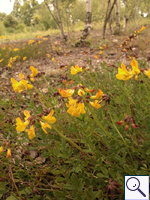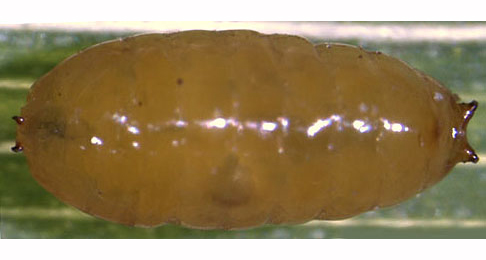|
||||||
|
HIPPOCREPIS. Horseshoe Vetch. [Fabaceae] |
|
|
Four species of Hippocrepis are recorded in Britain. These include the native Horseshoe Vetch (H. comosa). Three British miners are recorded on Hippocrepis elsewhere. A key to the European miners recorded on Hippocrepis is provided in Bladmineerders van Europa. |
 Horseshoe
Vetch
Horseshoe
VetchHippocrepis comosa |
Key for the identification of the known mines of British |
1a > Leaf-miner: A short, irregular, linear upper surface mine on any part of the leaf. Also recorded from young pods (Bland, 1997a). Long corridor mine. As a rule the first part of the mine is lower-surface, the later part upper-surface. Often the loops are so dense that a secondary blotch is the result. Because upper- and lower-surface corridor segments often cross, the mine obtains a strange array of transparant patches. There is no association with the midrib. Frass in strings and thread fragments. Pupation outside the mine; exit slit in upper epidermis. Mine not associated with the veins or midrib of the leaf (It is this character which enables distinction from another Agromyzid pest species - Liriomyza huidobriensis). The larvae may leave one leaf (if not large enough) and enter another leaf, via the petiole). It exits the leaf to pupate through a semi-circular slit in the upper surface of the leaf. |
|
Liriomyza bryoniae (Kaltenbach, 1858) [Diptera: Agromyzidae]. |
1b > Leaf-miner: Corridor leaf-mine in leaves. An upper surface linear mine with frass in conspicuous greenish strips, largely alternating at each side of the channel (Spencer, 1976: 241). Upper-surface, unbranched corridor, relatively broad from the start on, but only weakly widening subsequently. The fresh mine is bright green, but turns whitish, later brown, quickly. Frass in a wide green band in the centre of the corridor, with small black granules at either side. Pupation outside the mine. Forms an upper surface mine, with the frass in a green strips. |
 Liriomyza congesta puparium Image: © Willem Ellis (Bladmineerders van Europa) |
|
Liriomyza congesta (Becker, 1903) [Diptera: Agromyzidae]. |
1c > Leaf miner: An initial gallery, which usually follows the leaf margin. Then forms a blotch, mining from the leaf base to the tip. The presence of a pupa in the mine is unusual for this species and may indicate parasitism. Oviposition on the leaf underside. The mine begins as a long corridor with a very broad, green frass line. This corridor suddenly widens into a broad blotch, that in the end may occupy almost an entire leaflet. The blotch generally begins in the leaf base, and it is here that most frass is concentrated. Shortly before pupation the larva leaves its mine through an exit slit in the lower epidermis. After the mine has been vacated the leaflet drops off. |
|
Trifurcula cryptella (Stainton, 1856) [Lepidoptera: Nepticulidae]. |
| Last updated 05-Jul-2019 Brian Pitkin | ||
